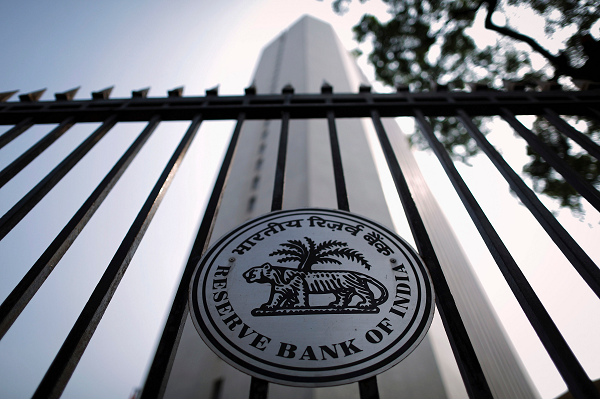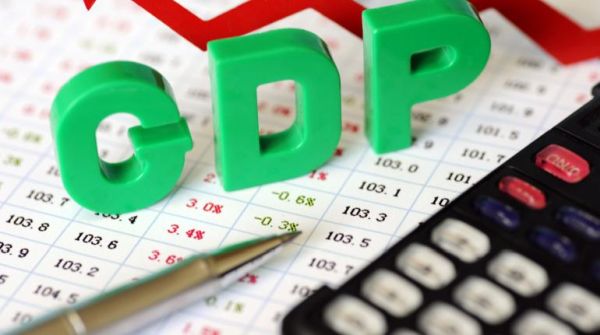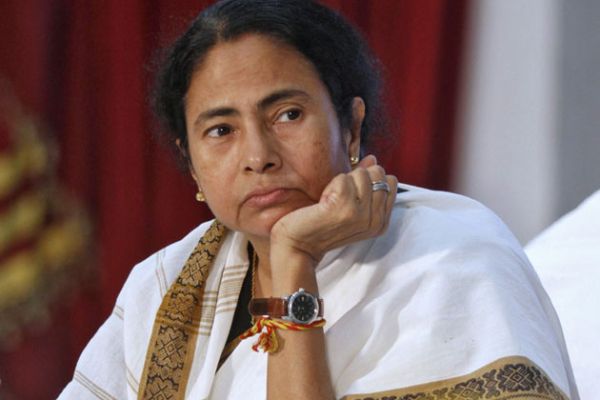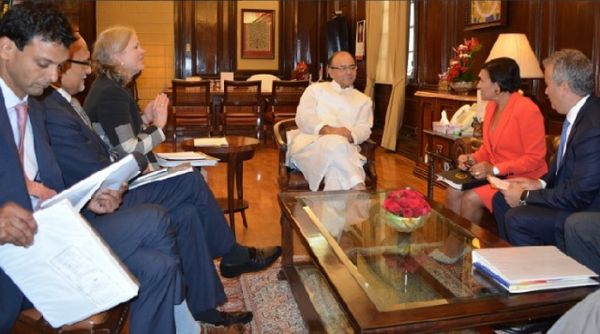
by admin | May 25, 2021 | Opinions
 By Amit Kapoor,
By Amit Kapoor,
The much-awaited second quarter gross domestic product (GDP) figures were released last week. It must have come as a relief to the Modi government that economic growth is finally on the upswing. After five successive quarters of decline, growth inched up to 6.3 percent in the July-September quarter after hitting rock bottom at 5.7 percent in the previous quarter. There was a mild sentiment of euphoria over this turnaround, but it is instructive to point out that even the worst quarter after the 2008 recession took India to a low of 6.9 percent. Clearly, we’ve left the last decade far behind.
Some might say that the comparison is unfair since the global economy was conducive to such levels of growth at the time. However, the impact of domestic factors in the growth decline over the previous five quarters cannot be refuted as OECD estimates put global growth to be the fastest since 2011. Also, demonetisation and GST were not the only two culprits of the slowdown in growth since it had begun much earlier. Private investment sentiments had already been muted due to a rising stock of bad loans.
Nevertheless, the adverse impact of all these factors seem to be nearing their end. A rise in GDP growth rate points to the fact that the impact of demonetisation and GST is finally wearing off and the government has over the last few months taken some crucial steps to deal with the problem of bad loans. But are we out of the woods yet?
The data released last week does not paint a promising picture. First, the growth rebound was brought about largely on account of the manufacturing sector. It grew by seven percent as compared to a paltry 1.2 percent during the April-June quarter. However, curiously, this figure is much higher than the 2.2 percent year-on-year growth in the same quarter based on the index of industrial production (IIP) data. The gap can only be explained by differences in methodology.
The IIP measures the change in production volumes as compared to the previous year while the GDP calculation measures the value addition taking place in the economy. Therefore, if production volumes remain the same over the year, IIP data will show no growth, but in the same scenario, if the price of inputs fall, GDP will grow positively. This is exactly how the recent growth in manufacturing has come about. Production volumes have not expanded as commensurately as production value. This is not a positive sign for a developing economy like India, where demand for jobs is ever expanding. Growth will not matter much if real production does not take place.
Second, a factor of growing concern for the economy is the problem of the fiscal deficit. The day GDP figures came out, stock markets reacted negatively due to the slippage on the fiscal front. Private investments have not seen any substantial revival since the last quarter and, in fact, gross fixed capital formation as a percentage of GDP has actually declined. The only thing keeping the economy running was increased government spending, but even that has been stretched beyond its limits. Barely more than half a year has passed, and the government has already spent 96 percent of its annual target. Since the government has made clear its intentions of sticking to the fiscal target, future growth prospects do not look promising and will solely depend on a revival of private sentiments.
Finally, a big worry for the Indian economy is its underperforming export sector. The growth in exports took place at merely 1.2 percent in the last quarter, which is hard to explain at a time when the global economies are at one of their strongest phases of growth in a long time. It is absolutely crucial to address this issue because, as repeatedly pointed out by veteran economic journalist Swaminathan S. Anklesaria Aiyar, no country in history has managed to grow at seven percent on a sustained basis without an export growth of at least 15 percent. India’s subdued export performance is puzzling and it needs to figure out what is inhibiting its growth. The recently-implemented GST framework could have put a spoke in the wheel. Addressing these policy bottlenecks can bring exports to an upward growth path.
All these factors, combined with the fact that private investment continues to remain weak, point to bleak prospects for the Indian economy. This will remain true for the next few quarters. Hopefully, when the complete impact of the recent string of reforms with GST, Real Estate Act and Bankruptcy Code start to kick in, a revival in private sentiments will take place and drive manufacturing and exports in the process. Until then the only ray of hope resides with the favourable external sector as a lucrative source of demand.
(Amit Kapoor is chair, Institute for Competitiveness, India. He can be contacted at amit.kapoor@competitiveness.in . Chirag Yadav, senior researcher, Institute for Competitiveness, India, has contributed to the article.)
—IANS

by admin | May 25, 2021 | Banking, Economy, Markets, News
 Mumbai : The Reserve Bank of India (RBI) is expected to keep its key interest rate unchanged at its penultimate monetary policy review of the fiscal on Wednesday owing to higher inflation in October and a surge in oil prices, even as the reversal in the decline of GDP growth during the second quarter has eased pressure on the central bank to cut rates.
Mumbai : The Reserve Bank of India (RBI) is expected to keep its key interest rate unchanged at its penultimate monetary policy review of the fiscal on Wednesday owing to higher inflation in October and a surge in oil prices, even as the reversal in the decline of GDP growth during the second quarter has eased pressure on the central bank to cut rates.
At its previous bi-monthly policy review here in October, the RBI had maintained status quo on its repo, or short term lending rate for commercial banks, at six per cent, citing risks to inflation and uncertainties on the external and fiscal fronts.
The central bank had earlier, in August reduced the repo, or its repurchase rate by 0.25 percentage points to six per cent.
According to the minutes of October’s Monetary Policy Committee (MPC) meeting, Governor Urjit Patel said: “We have to be vigilant on account of uncertainties on the external and fiscal fronts; this calls for a cautious approach.”
Japanese financial services major Nomura said in a report that input cost pressures are marginally higher now, which along with higher food inflation is likely to push retail inflation slightly above the RBI’s target of four per cent in November and beyond.
“We expect a hawkish hold from the RBI..and policy rates to remain unchanged through 2018,” it said.
Data released in November showed that India’s annual rate of inflation based on wholesale prices (wholesale price index) rose to 3.59 per cent in October due to an exponential rise in food prices.
In addition, the consumer price index (CPI), or retail, inflation for October rose to 3.58 per cent from 3.28 per cent in September.
Domestic credit rating agency ICRA said the MPC would leave the repo rate unchanged at six per cent “in a non-unanimous decision in the December 2017 policy review, given the expectation of a further rise in the CPI inflation in the coming months”.
On the other hand in October, the central bank lowered the country’s growth projection for 2017-18, pegging the Gross Value Added (GVA) to 6.7 per cent, from earlier estimate of 7.3 per cent.
Declaring that inflation is expected to rise from the then-level of around 3.3 per cent “and range between 4.2-4.6 per cent in the second half of this year”, Patel said the MPC remains committed to keeping headline inflation close to four per cent “on a durable basis”.
Five members of the six-member MPC voted in favour of maintaining the key lending rate.
The MPC had expressed concern about the upside risks to inflation and that implementation of farm loan waivers by states may result in fiscal slippages resulting in upward pressure on prices.
“Although the domestic food price outlook remains largely stable, generalised momentum is building in prices of items excluding food, especially emanating from crude oil. The possibility of fiscal slippages may add to this momentum in the future,” it said.
Breaking a five-quarter slump, a rise in the manufacturing sector’s output pushed India’s growth rate higher to 6.3 per cent during the second quarter ending September, official data showed last week.
On a sequential basis, GDP growth for the second quarter went up to 6.3 per cent, from 5.7 per cent reported during the first quarter of 2017-18.
On the oil price front, the Indian basket, comprising 73 per cent sour-grade Dubai and Oman crudes, and the balance in sweet-grade Brent, regained the $60 a barrel level in November and closed trade on November 30 at $61.60.
—IANS

by admin | May 25, 2021 | Economy, Markets, News
 Mumbai : The equity markets turned bearish during the week on growing concerns over the country’s widening fiscal deficit as well as rising crude oil prices and persistant selling by foreign institutional investors (FIIs).
Mumbai : The equity markets turned bearish during the week on growing concerns over the country’s widening fiscal deficit as well as rising crude oil prices and persistant selling by foreign institutional investors (FIIs).
According to market observers, upbeat gross domestic product (GDP) growth data for the second quarter of 2017-18 failed to cheer the equity markets as investors remained cautious ahead of major events in the upcoming week.
The barometer 30-scrip Sensitive Index (Sensex) of the Bombay Stock Exchange (BSE) dropped 846.3 points, or 2.51 per cent, to close the week at 32,832.94 points.
The broader Nifty50 of the National Stock Exchange (NSE) declined by 267.9 points, or 2.58 per cent, to close at 10,121.80 points.
“Markets ended sharply lower this week after consolidating in a range for major part of the week. Selling emerged in the last two sessions of the week,” Deepak Jasani, Head – Retail Research, HDFC Securities, told IANS.
D.K. Aggarwal, Chairman and Managing Director of SMC Investments and Advisors, said the domestic market got spooked by fiscal deficit readings ahead of expiry of November contracts.
“To note, India’s fiscal deficit at the end of October hit 96.1 per cent of the budget estimate for the fiscal year ending in March 2018,” Aggarwal told IANS.
“In the week gone by, the Dow industrials pushed past the 24,000 mark for the first time on the back of tax-reform optimism amid the latest batch of economic data pointing to a pickup in global and domestic demand. In a recent meeting, OPEC (Organisation of the Petroleum Exporting Countries) members agreed to extend curbs on output to the end of next year,” he added.
Provisional figures from the stock exchanges showed that domestic institutional investors bought scrips worth Rs 1,614.89 crore.
FIIs continued to remain net sellers and sold stocks worth Rs 2,772.56 crore during the week.
“Widening fiscal deficit and rising crude oil prices concerns continued to hurt sentiment. Investors turned cautious ahead of major events in the month ahead — the Reserve Bank of India policy, Federal Open Market Committee meet and Gujarat assembly elections,” said Arpit Jain, AVP at Arihant Capital Markets.
Figures from the National Securities Depository (NSDL) revealed that foreign portfolio investors (FPIs) invested in equities worth Rs 3,273.34 crore, or $506.06 million, from November 27-30.
On the currency front, the rupee strengthened by 23 paise to close at 64.47 against the US dollar from its last week’s close at 64.70.
The currency market was closed on December 1 on the occasion of Id-e-Milad.
The top weekly Sensex gainers were: Maruti Suzuki (up 1.41 per cent at Rs 8,607.55); Coal India (up 0.42 per cent at Rs 272.25); and NTPC (up 0.42 per cent at Rs 181.15).
The losers were: Tata Motors (down 6.07 per cent at Rs 399.15); State Bank of India (down 5.93 per cent at Rs 312.55); Infosys (down 5.09 per cent at Rs 958.50); Tata Motors (DVR) (down 4.92 per cent at Rs 228.85); and Adani Ports (down 4.46 per cent at Rs 386.90).
—IANS

by admin | May 25, 2021 | Economy, News, Politics

Mamata Banerjee
Kolkata : Taking a dig at the central government on GDP numbers, West Bengal Chief Minister Mamata Banerjee on Thursday said “effects of note ban scam” and “unplanned” implementation of Goods and Services Tax (GST) continue to damage India’s economy.
According to official data released on Thursday, gross domestic product (GDP) at constant prices in the second quarter of the current fiscal was estimated at Rs 31.66 lakh crore, as against Rs 29.79 lakh crore in same period of last fiscal, showing a growth rate of 6.3 percent.
“GDP figures out. Again no growth. No jobs. Effects of note ban scam & unplanned GST continue to damage economy. Only talking. No performance,” Banerjee said in a tweet.
“Last year Q2 GDP growth was 7.5 per cent and this year it is 6.3 per cent. This Govt only bhashan, no action,” she added.
—IANS

by admin | May 25, 2021 | Economy, News, Politics

Arun Jaitley
New Delhi : Lauding the upward movement of the GDP number for the second quarter of 2017-18, Finance Minister Arun Jaitley said the rise in growth after five quarters marks the reversal of the trend and the economy will witness high growth rates in the coming quarters.
“Last five quarters have witnessed downward trend. The 6.3 per cent rise during Q2 of 2017-18 marks the reversal of that trend. This additionally indicates that the impact of demonetisation and Goods and Services Tax is now behind us and hopefully in the coming quarters will take an upward trajectory,” Jaitley said at a press meet here on Thursday.
He said while this was broadly an initial analysis of the figures, “hopefully we can take to higher growth rate in the coming quarters.”
Jaitley said if one looked at the overall picture since May 2014, out of 13 quarters the economy clicked 7 per cent growth eight times. “We have fallen behind 6 per cent only once. This marks a reversal and it has been largely enabled by manufacturing while investment has moved up. These are the two significant features.”
Official data released revealed that a rise in the manufacturing sector’s output pushed India’s growth rate higher to 6.3 per cent during the second quarter of 2017-18 breaking a five quarters slump.
On a sequential basis, India’s GDP growth for Q2 of the current fiscal went up to 6.3 per cent, from 5.7 per cent reported during the first quarter of 2017-18.
In a statement the finance ministry said the real GDP growth for the second quarter of fiscal 2017-18, just released by the CSO, is estimated at 6.3 percent, a substantial increase from 5.7 percent in the first quarter.
Real Gross Value Added growth has shown a similar increase from 5.6 percent in the first quarter to 6.1 percent in the second quarter, despite a deceleration in agricultural growth from 2.3 percent in the first quarter to 1.7 percent in the second.
The deceleration in overall growth witnessed since the first quarter of the last fiscal year has been reversed, the statement added.
“The acceleration in growth this quarter has been helped by a rapid growth in manufacturing which increased from 1.2 percent in the first quarter to 7 percent in the second quarter. Robust growth of 7.6 percent in electricity and other utilities, and 9.9 percent in trade, transportation and communications also powered this acceleration,” the ministry said.
Overall, the services sector recorded a growth of 7.1 percent in the second quarter.
It stated the rate of growth of gross fixed capital formation has also increased from 1.6 percent in the first quarter to 4.7 percent in the second quarter. Real private consumption growth has broadly held steady at 6.5 percent.
“In summary, the economy now seems to have weathered the transitional challenges experienced earlier in the year and appears poised for a durable recovery going forward.”
—IANS




